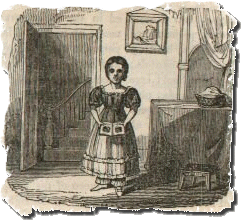Nineteenth-Century American Children & What They Read


When most people think of nineteenth-century American children’s books, they think of works like Louisa May Alcott’s Little Women (1868), or Mark Twain’s Tom Sawyer (1876). Or maybe they think of Horatio Alger’s books, like Ragged Dick (1867). But there were other, earlier books that were equally popular—so popular that one author was mobbed by excited children when he made a tour in the 1840s.
I’ve collected and studied early American children’s books and magazines for almost two decades. My main interest is works by Samuel Griswold Goodrich (1793-1860), the man mobbed by children when he toured the South in 1846. He created Peter Parley, one of the most popular characters in American children’s books, and Robert Merry’s Museum, a popular children’s magazine that ran for 32 years. No, you probably haven’t heard of them, but they were important in their time.
I’ve also been interested in the children themselves. Most of us have an idealized vision of 19th-century American children and their families. But children have been children from the beginning of time: endearing, irritating, beautiful, frustrating. And family life has never been ideal.
Here you’ll find bits and pieces that I’ve collected or found interesting about nineteenth-century American children. You’ll also find works selected from early children’s books and magazines. This web page is constantly under construction; I try to add something new each month.
A timeline: Children’s books and magazines, works transcribed at this site, and some events in U. S. history, arranged chronologically.
I’ve written about some of the material you find here; these papers aren’t readily available. I update the essays without notice as I find more information or change my mind about things.
“Robert Merry’s Museum and the Lure of the Sensational” was presented at the American Culture Association conference in 1988. In the pages of the Museum, the only good book was a dull one.
“Death and the Readers of Robert Merry’s Museum” was presented at the American Culture Association conference in 1994. It explores the way death was discussed in letters written to the Museum by its subscribers.
“Too Good to Be True: 150 Years of Mary Sue” is the long version of a paper presented at the American Culture Association conference in 1999. It’s only marginally about the Museum; I was interested in exploring a type of character seen in fiction written by amateurs: a character who stands in for the author of the story and who annoys most readers with her perky perfection. Please note that this paper makes reference to subjects of a sexual nature; don’t read it if you will be offended.
“An ‘Online Community’ of the Nineteenth Century” is the unabridged version of a paper presented at the American Culture Association conference in 2001. It’s a thorough discussion of “Merry’s Monthly Chat with His Friends” as an early example of an online community. The Chat had it all: gender-swapping, flame wars—you name it. This epic piece is presented here with links to several pieces at this site. (Many letters quoted in the paper appear in Letters from American Children to Robert Merry’s Museum Magazine, updated online as “Dear Friend Robert Merry”: Letters from 19th-century Children.)
“Clement Clarke Moore and ‘A Visit from St. Nicholas’ ” originally appeared as the introductory essay for the the 2001 exhibition catalog of the Barbara Loftus Perrone Collection of editions of “A Visit from St. Nicholas.” The paper includes links to transcriptions of early printings of “Visit.”
“Choosing the Right Path: Didacticism in the Choose-Your-Own-Adventure Books” (1986) is a paper based on my collection of 20th-century “choose-your-own-adventure” books. These books, in which the reader becomes the protagonist of the story, were extremely popular from their first publication in the 1970s; there was a series for adults (sleep with the boss?/don’t sleep with the boss?), and some popular movies (Staying Alive) were replayed through these books. Readers also could guide popular characters (Indiana Jones, Superman, Spock, the Muppets) through an adventure. As entertaining to me were the social values on which the action of the books seemed to depend.
I’ve compiled several annotated bibliographies of sources on 19th-century American social history, children, and children’s books and magazines. I add to the bibliographies as I find sources.
19th Century Girls’ Series, a site maintained by noted series-book expert Deidre Johnson. Here you’ll find more information on Jacob Abbott and Sophie May, selections from 19th-century series books, a section on Edward Stratemeyer (Johnson is the author of Stratemeyer Pseudonyms and Series Books, a basic reference in the field), and the text of one of the few dime novels written for girls!